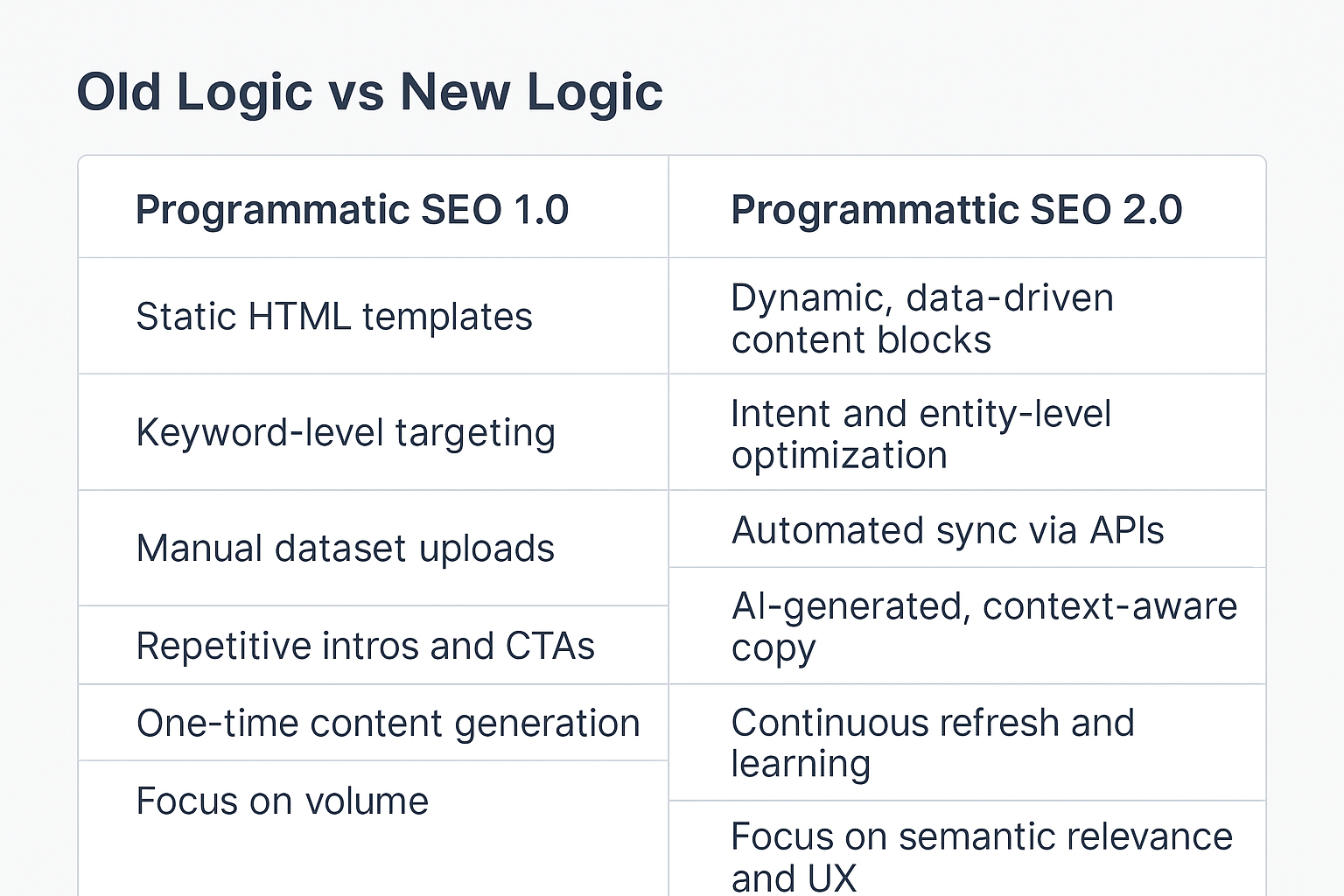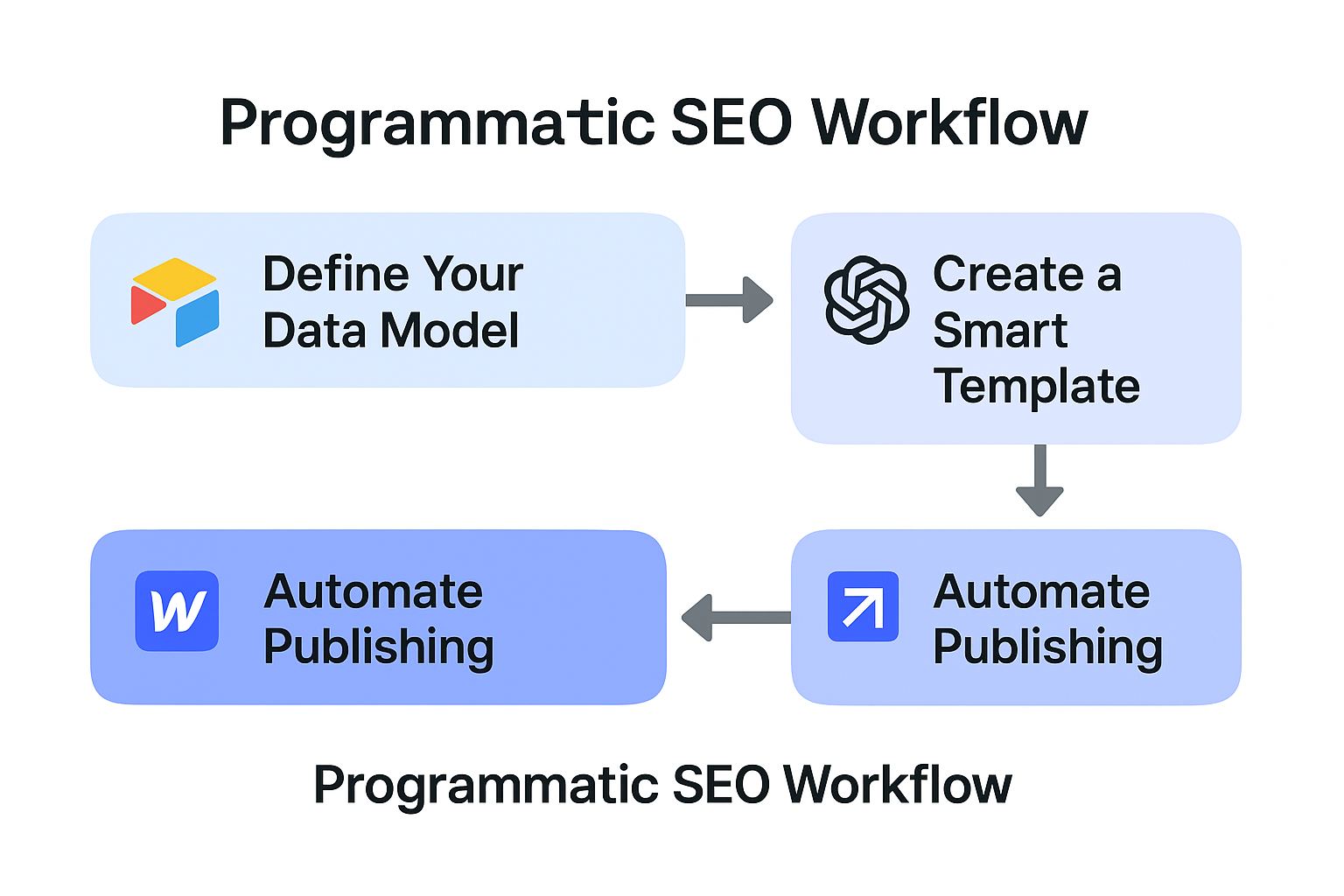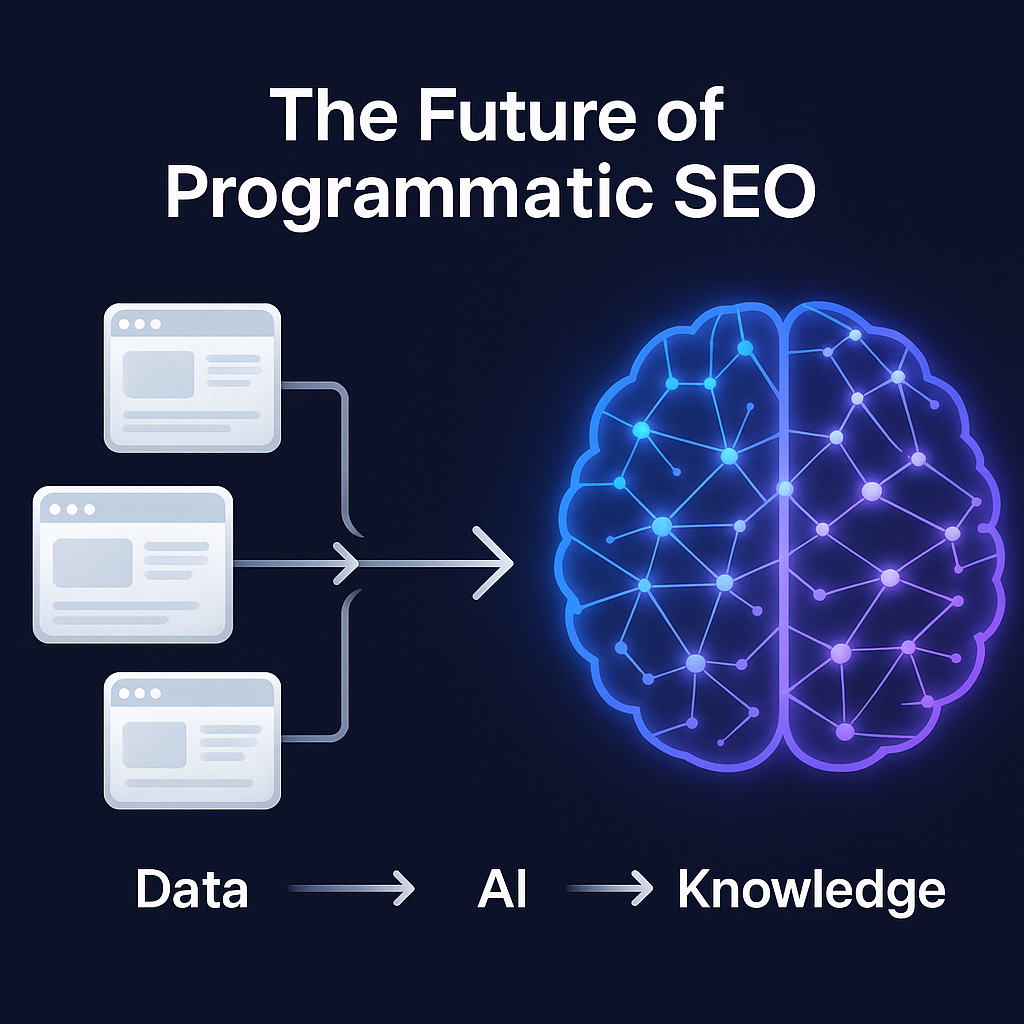November 21, 2025
Semantic Blocks: The New Structure of AI-Optimized Content
November 20, 2025
Multimodal SEO: How AI Uses Images, Video & Diagrams to Rank Pages
November 19, 2025
Author:
.png)
Programmatic SEO has always been about scale - automating the creation of thousands of landing pages through structured datasets and smart templates. It allowed businesses to dominate long-tail keywords and capture massive organic traffic with minimal manual effort.
But that old model - static templates, repetitive content, and keyword-stuffed copy - is quickly becoming obsolete. Search engines in 2025 no longer reward volume; they reward context, meaning, and data precision.
Welcome to Programmatic SEO 2.0 - where automation meets intelligence.
This new era combines AI-driven content generation, structured data, and entity-based optimization to create not just pages, but knowledge frameworks that search engines can interpret and trust.
It’s not about flooding the index anymore - it’s about crafting dynamic, self-optimizing ecosystems that continuously learn, update, and scale.
In 2025, Programmatic SEO isn’t about generating pages - it’s about generating meaning.
The first generation of Programmatic SEO (2015–2022) was revolutionary for its time. It enabled marketers to create thousands of pages automatically using structured datasets — typically combinations of cities, products, and services. For years, this approach dominated long-tail search by sheer scale.
But as the web evolved, so did its weaknesses.
Programmatic SEO 1.0 produced pages that looked different on the surface but delivered nearly identical intent. Users bounced quickly, engagement dropped, and search engines learned to detect thin content.
The formula — “city + keyword + template” — stopped working.
Programmatic SEO 2.0 (2023–2025) marks a new era. It blends AI, semantic understanding, and real-time data automation into the process.
Instead of generating static, keyword-heavy pages, brands now build dynamic content ecosystems that adapt to user intent and stay fresh through automated updates.

The shift is clear: modern Programmatic SEO isn’t about mass production. It’s about smart automation. AI now understands nuance, intent, and relationships between entities, allowing your pages to feel human-crafted while scaling faster than ever.
Programmatic SEO examples today look more like living systems - continuously updated, semantically connected, and aligned with how AI-powered search engines interpret meaning.
Programmatic SEO 2.0 isn’t just about scale - it’s about precision at scale.
The new generation of programmatic frameworks merges data architecture, semantic writing, and AI automation to create systems that both users and search engines understand.
Here are the four pillars that define the modern approach 👇
In the old world, success depended on keyword research.
Now, it depends on how well you structure your data model - every column, attribute, and entity matters.
Example:
Instead of a dataset like
“hotel name | city | rating | price,”
you build a relational model:
“Destination → Type → Features → Sentiment → Availability.”
The richer the dataset, the more context AI and search engines can extract - enabling deeper, intent-based indexing.
Forget about static templates with token replacements like {city} or {product}.
Programmatic SEO 2.0 uses semantic templates - flexible text blocks that adjust tone and content based on data input.
For example:
A template for “Best gyms in {city}” dynamically changes structure if {city} = “Berlin” (focus on modern design & tech) vs “Lisbon” (focus on community & weather).
This makes each page feel human-written - not cloned.
AI automates 90% of the work, but human review gives direction and tone.
The most successful programmatic frameworks combine:
Instead of editing thousands of pages, editors now focus on patterns - improving templates that update all pages at once.
Structured data is what connects your content to search understanding.
AI Schema Enrichment automates the creation of FAQ, HowTo, Product, Review, and LocalBusiness markup at scale.
Example:
Automatically generating FAQPage schema from dataset Q&A fields or reviews summary.
AI tools can even detect missing entities (e.g., brand, product specs) and fill them in dynamically - keeping your schema complete and consistent across thousands of pages.
Together, these four principles redefine what scalability means.
It’s no longer about producing more pages - it’s about producing smarter, self-optimizing pages that grow and evolve with your data ecosystem.
Programmatic SEO 2.0 isn’t just a strategy — it’s an automated workflow that connects data, templates, and publishing into a single scalable ecosystem.
To build a modern programmatic SEO system, every element must be data-driven, dynamic, and measurable.
The foundation of scalable SEO pages is a structured dataset.
Start by identifying clear entity relationships, for example:
Product → Category → Specs → Country
or
City → Service → Feature → User Intent.
Each entity helps AI understand context and relationships, making your pages more relevant.
Store the data in Sheets, Airtable, or a database connected via API — so that every update in your dataset automatically syncs with the content.
A clean data model is what makes your programmatic SEO workflow predictable, maintainable, and ready for automation.
A smart template turns raw data into meaningful pages.
Instead of static layouts, use semantic templates built around tokens like {city}, {brand}, {feature}, and {intent}.
Add logic rules that adapt tone and structure:
If {intent} = informational → generate a guide-style layout.
If {intent} = transactional → emphasize benefits and CTAs.
Integrate GPT-based automation to generate introductions, FAQs, and schema from your dataset.
This transforms every template into a flexible, AI-powered content block capable of producing hundreds of unique, high-quality pages.
Once your templates and data are ready, connect everything through automation tools such as n8n, Make, or Zapier.
These integrations push data directly to your CMS (Webflow, WordPress, or custom setups), automatically creating new pages and optimizing them in real time.
Automation can handle:
This is the true power of AI SEO automation — the ability to generate and publish optimized content without touching a single CMS field manually.
Modern programmatic SEO doesn’t stop at publishing — it learns and adapts.
Track impressions, CTR, and AI visibility using Google Search Console, Looker Studio, or SpotRise.ai.
When metrics decline, trigger automatic refreshes of meta tags, schema, and copy through GPT models.
By connecting data analytics and automation, your pages evolve continuously — ensuring long-term growth and relevance without human micromanagement.
Programmatic SEO 2.0 transforms SEO from a manual process into a living, data-driven system — where every update, click, and impression feeds back into smarter automation.

Artificial Intelligence has become the engine behind Programmatic SEO 2.0 — turning static templates into adaptive ecosystems. What once required manual input, rewriting, and QA, can now happen in real time, across thousands of pages.
Here’s how AI completely reshapes the workflow 👇
1. Content Contextualization
AI models transform raw datasets into natural, human-like narratives. Instead of simple data merges, they generate contextually relevant paragraphs, varying tone and focus depending on entity type, intent, and user journey.
A dataset that once produced repetitive “Best hotels in {city}” pages can now generate unique storytelling around each destination — local culture, ratings, and reasons to visit.
2. Entity Recognition & Semantic Cohesion
Modern SEO depends on entities, not keywords.
AI systems like GPT-4 or custom NLP pipelines identify entity relationships automatically — ensuring each page’s content connects to the right brands, features, and categories.
This leads to semantic cohesion across clusters, which search engines interpret as topical authority.
3. Automated Rewriting
Programmatic SEO used to struggle with duplication. AI now rewrites sections intelligently — keeping factual data intact while refreshing tone and sentence structure. This means thousands of scalable SEO pages remain unique, readable, and index-safe.
4. Quality Control
AI quality models flag thin content, outdated facts, or incomplete schema before publishing. Instead of post-factum audits, QA becomes proactive and automated, saving weeks of manual review.
By combining all these layers, AI-driven programmatic SEO creates pages that are not just scalable — they’re valuable. Every generated page adds new meaning, reinforcing the site’s topical depth instead of diluting it.
The best way to understand the potential of programmatic SEO is to look at how real industries apply it in 2025.
Example 1: SaaS Comparison Platforms
Websites generate thousands of pages like “Best CRM tools for small businesses” or “Email automation platforms by industry.”
AI analyzes product features, user reviews, and pricing data to generate concise, data-driven comparisons.
Result: +40% impressions and +25% conversion lift within 3 months due to deeper keyword coverage and semantic interlinking.
Example 2: Travel Destination Networks
Each page includes a dynamically generated introduction, FAQs, and schema built from live datasets — weather, local activities, ratings, and average prices.
Instead of “thin” location pages, the system produces rich, updated experiences that feel written by a local expert.
Example 3: Automotive Marketplaces
Large datasets of brands, parts, and models feed directly into AI templates. Pages like “Best brake pads for BMW X5 2019” or “Top wiper blades for Audi A4” get auto-generated with specs, compatibility, and product reviews.
Result: Thousands of long-tail queries indexed, with improved CTR due to structured data and entity clarity.
These programmatic SEO examples show the new formula: structure + AI + freshness = exponential visibility.
Scalability without measurement means chaos.
To keep control, programmatic SEO systems must track not just traffic, but the quality and impact of every page.
Core metrics for 2025:
By connecting Google Search Console, Looker Studio, and tools like SpotRise.ai, you can visualize clusters as living ecosystems — understanding how your datasets grow and which entities drive results.
The most advanced systems go further: they connect metrics back to automation.
If a page underperforms, it triggers a rewrite, schema update, or internal linking boost automatically.
This is what SEO automation tracking really means — not dashboards, but self-optimizing frameworks.
Even advanced teams fall into old traps when scaling content. The difference between success and failure in programmatic SEO often lies in execution discipline.
1. Generating Too Many Low-Quality Pages
Mass generation without entity differentiation floods Google with near-duplicates.
Fix: filter and group your datasets by unique search intent before publishing.
2. Ignoring Internal Linking Logic
Thousands of pages without a structured interlink network won’t build topical authority.
Fix: create automated internal linking rules (e.g., every page links to its parent entity and two sibling entities).
3. Overusing AI Without Grounding
Generic AI content breaks trust and lowers engagement.
Fix: always pair AI writing with factual datasets — numbers, comparisons, or verified attributes.
4. Skipping Schema and Indexation Checks
AI can’t fix poor technical SEO. Missing canonical tags or invalid markup will still block indexing.
Fix: include schema validation and indexation status checks in your automation cycle.
Avoiding these programmatic SEO mistakes ensures that your automation actually compounds — instead of cannibalizing your visibility.

The next evolution of Programmatic SEO will go far beyond static content generation.
We’re entering an era of knowledge generation, where AI transforms your datasets into interconnected graphs of meaning.
Programmatic SEO 2.0 merges AI, structured data, and automation — creating living ecosystems, not static templates.
The future belongs to those who build systems that think, not just pages that rank.
Хочешь, я теперь сделаю финальный визуал — “The Future of Programmatic SEO” (мозг из нейронов, соединённый с сетью страниц и стрелками “Data → AI → Knowledge”)?
Your new AI assistant will handle monitoring, audits, and reports. Free up your team for strategy, not for manually digging through GA4 and GSC. Let us show you how to give your specialists 10+ hours back every week.
Read More

November 21, 2025
10 min

November 20, 2025
10 min

November 19, 2025
10 min
Just write your commands, and AI agents will do the work for you.